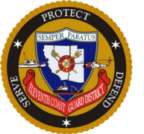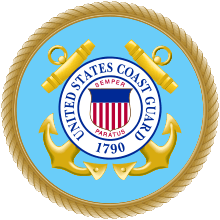United States Coast Guard sector
A Sector is a shore-based operational unit of the United States Coast Guard. Each Sector is responsible for the execution of all Coast Guard missions within its Area of Responsibility (AOR), with operational support from Coast Guard Cutters and Air Stations. Subordinate commands within a Sector typically include Stations and Aids-to-Navigation (ATON) Teams. Some Sector commands also have subordinate units such as Sector Field Offices and Marine Safety Units that are responsible for mission execution in parts of the Sector's AOR. There are 37 sectors within the Coast Guard.
History
Sectors replaced Coast Guard Groups, Marine Safety Offices (MSO), Activities, and Vessel Traffic Services (VTS). Previously, a Group and its units provided Search and Rescue (SAR), maritime law enforcement, recreational boating safety, and maintained aids to navigation. MSOs enforced federal laws and regulations related to the safety and security of vessels, port facilities, and the marine environment, and assisted other law enforcement agencies. The new Sector organizations are based on the Activities prototype commands established in 1996 in New York and Baltimore, and (later) San Diego. The Activities units were praised for their efficiency and unity of effort in the aftermath of the 9/11 attacks.
Before 2004, field operations in a single port fell under multiple, mission-based commands (Group, MSO, and VTS) that were physically dispersed, had unique chains of command and different program managers at Coast Guard Headquarters, lacked a consistent voice to the public, and had some mission overlap. The attacks of September 11 called for a new Coast Guard unity of effort that was cumbersome to achieve using the previous multiple command port-level structure. The Coast Guard’s move from the Department of Transportation to the Department of Homeland Security and implementation of the Maritime Transportation Security Act of 2002 (MTSA) provided further impetus to restructure.
In 2003, the Coast Guard began to consolidate field activities for its Commercial Vessel Safety, Port and Environmental Safety, Marine Environmental Response, Port Security, Waterways Management, Bridge Administration, Search and Rescue (SAR), Recreational Boating Safety missions under one local Sector Command. The organizational change to Sectors eliminated the historical segregation of prevention and response activities at the local level and created a comprehensive unit that brings together field activities, authorities, and resources to provide the most effective organization and the best value to the public.
The Sector Command combines responsibilities and authorities previously shared by two or more commands into a single operational unit with a command and senior staff of highly competent experts.[1]
The Coast Guard Sector provides for rapid, coordinated response to emergencies, whether natural (such as Hurricane Katrina) or man-made, along with integrated daily operations to enforce regulations governing marine safety, security, and environmental protection. In addition, it provides an immediate safety and security assessment at the onset of any maritime event, disaster, or casualty affords critical synergy to operations essential to marine safety, security, and environmental protection.[2]
Coast Guard Sectors serve as one-stop-shops for marine safety, security, and environmental protection for major seaports and regions. They bring multi-mission capabilities to life on the front lines of the maritime environment, where Sector Commanders are afforded broad authority.[3]
Organization
The Sector organizational construct represents a transformation from a Coast Guard traditionally organized around its operational programs to one organized around core operational service delivery processes. It focuses the coordinated efforts of all assigned operational capabilities to accomplish Coast Guard mission objectives.
Sector Commander
The commanding officer of a Sector is called the Sector Commander and is usually the rank of Captain. The Sector Commander holds the positions of Captain of the Port (COTP) and Federal Maritime Security Coordinator (FMSC). Unless otherwise assigned, the Sector Commander is also the Officer in Charge Marine Inspections (OCMI), Search and Rescue Mission Coordinator (SMC), and Federal On-Scene Coordinator (FOSC). The Sector Commander reports to the appropriate District Commander.
Command Staff
The Sector Commander's second-in-command is the Deputy Sector Commander. Also reporting directly to the Sector Commander are the:
Command Center
The Sector Command Center (SCC) is the center of Sector Operations. It provides 24-hour command, control, coordination, communications, intelligence, sensor analysis, and data mining (C4ISM). The SCC coordinates with other federal, state, and local operations centers, and issues Notices to Mariners, Situation Reports, and maritime security alerts. The SCC displays the current Common Operating Picture (COP) and Common Intelligence Picture (CIP), including a presentation of all vessels, aircraft, communications equipment, and personnel belonging to the Coast Guard and supporting agencies.
Contingency Planning and Force Preparedness
The Contingency Planning and Force Readiness Staff develops and maintains plans covering readiness, logistics, and emergency preparedness. It coordinates with the three departments in plan development and execution, and plans and executes readiness exercises to test contingency plans. The Contingency branch also monitors the training and readiness of Sector Reserve Forces and manages their mobilization and demobilization. The Contingency Planning and Force Readiness staff also manages the federally mandated Area and Area Maritime Security Committees around the nation.
Intel
The Intelligence Staff is envisioned to collect, evaluate, report, and disseminate operational intelligence within the Sector. This staff will serve as the primary intelligence support element for all operations within the Sector. This staff forwards its analysis of raw intelligence reports to the District and the Atlantic or Pacific Maritime Intelligence Fusion Center, and will be the critical link between the Sector Commander and the entire Coast Guard intelligence enterprise, which is in turn a part of the United States Intelligence Community.
Response
The Response Department contains two Divisions:
- Incident Management Division: Addresses SAR, pollution, and all hazards.
- Enforcement Division: Provides administration and oversight to the Coast Guard Boat Stations and Cutters that enforce U.S. law and PWCS enforcement activities, such as armed boardings, vessel escorts and security zone enforcement. This division works closely with federal, state, and local law enforcement and sister agencies within the DHS to respond to and mitigate the impact of maritime threats.
Prevention
The Prevention Department consists of three divisions.
- Inspections Division: Manages and oversees the regulatory and inspection aspects of the Coast Guard’s safety, security, and environmental protection responsibilities for vessels and facilities.
- Waterways Management Division: Controls aids to navigation; safety and security zones; Regulated Navigation Areas; ice breaking; and VTS and AIS.
- Investigations Division: Initiates inquiries into marine casualties, pollution, boating violations, and assessment of civil penalties.
Logistics
The Logistics Department performs unit level maintenance and organic engineering, personnel, medical support, and finance/supply functions for the entire Sector.
- Engineering/Support Division: Administers electronics and computer system, naval, aviation, vehicle, and facilities engineering; armory and small arms qualification; and environmental compliance. The associated Integrated Support Command or Aircraft Repair and Supply Center handle intermediate and depot level maintenance.
- Administrative/Personnel Division: Handles medical, training, housing, and educational services.
- Finance/Supply Division: Encompasses galley, transportation, and property and inventory management.
List of Coast Guard Sectors

Atlantic Area
| District | District Logo | Sector | Location of Sector command |
|---|---|---|---|
| District One |  |
Sector Northern New England | South Portland, Maine |
| Sector Boston | Boston, Massachusetts | ||
| Sector Southeast New England | Woods Hole, Massachusetts | ||
| Sector Long Island Sound | New Haven, Connecticut | ||
| Sector New York | Staten Island, New York | ||
| District Five |  |
Sector Delaware Bay | Philadelphia, Pennsylvania |
| Sector Maryland-National Capital Region | Baltimore, Maryland | ||
| Sector Hampton Roads | Portsmouth, Virginia | ||
| Sector North Carolina | Atlantic Beach, North Carolina | ||
| District Seven |  |
Sector Charleston | Charleston, South Carolina |
| Sector Jacksonville | Jacksonville, Florida | ||
| Sector Miami | Miami, Florida | ||
| Sector Key West | Key West, Florida | ||
| Sector St. Petersburg | St. Petersburg, Florida | ||
| Sector San Juan | San Juan, Puerto Rico | ||
| District Eight |  |
Sector Ohio Valley | Louisville, Kentucky |
| Sector Upper Mississippi | St. Louis, Missouri | ||
| Sector Lower Mississippi | Memphis, Tennessee | ||
| Sector Mobile | Mobile, Alabama | ||
| Sector New Orleans | New Orleans, Louisiana | ||
| Sector Houston-Galveston | Houston, Texas | ||
| Sector Corpus Christi | Corpus Christi, Texas | ||
| District Nine |  |
Sector Buffalo | Buffalo, New York |
| Sector Detroit | Detroit, Michigan | ||
| Sector Lake Michigan | Milwaukee, Wisconsin | ||
| Sector Sault Ste. Marie | Sault Ste. Marie, Michigan |
Pacific Area
| District | District Logo | Sector | Location of Sector command |
|---|---|---|---|
| District Eleven |  |
Sector San Francisco | San Francisco, California |
| Sector Humboldt Bay | McKinleyville, California | ||
| Sector Los Angeles - Long Beach | San Pedro, California | ||
| Sector San Diego | San Diego, California | ||
| District Thirteen |  |
Sector Puget Sound | Seattle, Washington |
| Sector Columbia River | Astoria, Oregon | ||
| Sector North Bend | North Bend, Oregon | ||
| District Fourteen |  |
Sector Honolulu | Honolulu, Hawaii |
| Sector Guam | Santa Rita, Guam | ||
| District Seventeen |  |
Sector Anchorage | Anchorage, Alaska |
| Sector Juneau | Juneau, Alaska |
See also
- United States Coast Guard
- Organization of the United States Coast Guard
- U.S. Coast Guard Cutters
- U.S. Coast Guard Air Stations
- Category:United States Coast Guard bases
References
- United States Coast Guard Press Release. Statement of Admiral Thad W. Allen on the Challenges Facing the Coast Guard's Marine Safety Program, delivered before the House Subcommittee on Coast Guard and Maritime Transportation Committee on Transportation And Infrastructure. August 2, 2007, https://www.piersystem.com/go/doc/786/166737/, accessed 2007-08-03. This is a work of the United States Government and is in the public domain.
- Adm. Allen, August 2, 2007, op.cit.
- Adm. Allen, August 2, 2007, op.cit.

